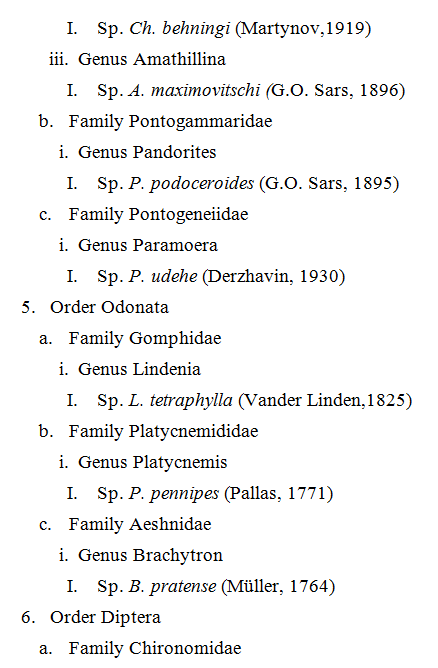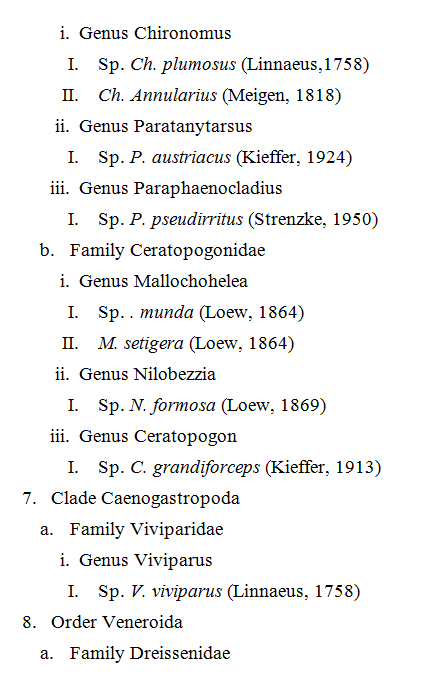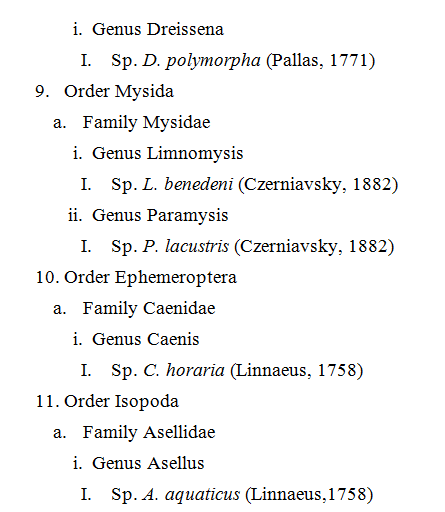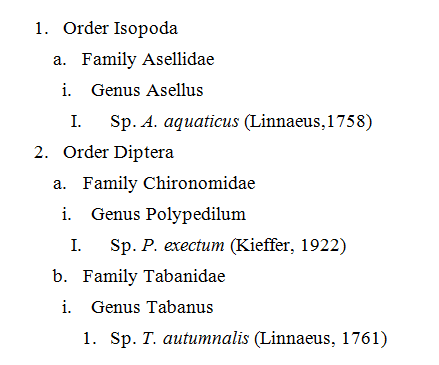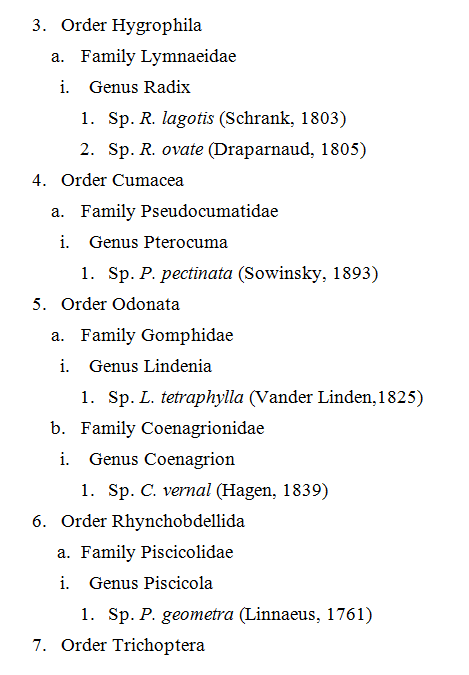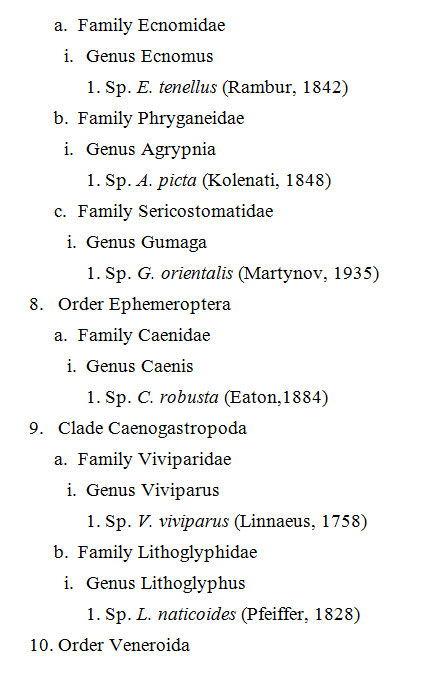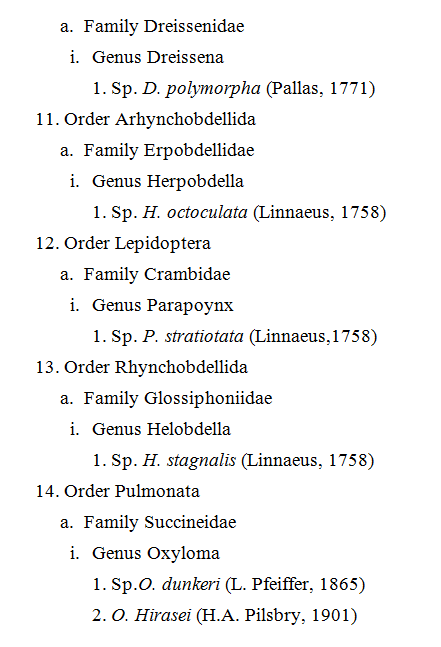НЕКОТОРЫЕ ДАННЫЕ О ВИДОВОМ СОСТАВЕ ДОННЫХ ОРГАНИЗМОВ НА ТЕРРИТОРИИ АСТРАХАНСКОГО ГОСУДАРСТВЕННОГО ПРИРОДНОГО БИОСФЕРНОГО ЗАПОВЕДНИКА
Ульянова А.С.
Аспирант 3-его года обучения, Астраханский государственный технический университет
НЕКОТОРЫЕ ДАННЫЕ О ВИДОВОМ СОСТАВЕ ДОННЫХ ОРГАНИЗМОВ НА ТЕРРИТОРИИ АСТРАХАНСКОГО ГОСУДАРСТВЕННОГО ПРИРОДНОГО БИОСФЕРНОГО ЗАПОВЕДНИКА
Аннотация
Донные организмы играют важную роль в биоценозе любого водоема. Изучение динамики численности и биомассы являются одними из основных направлений в исследовании кормовой базы рыб. Видовой состав зообентоса также является важным направлением исследований. Эта статья представляет собой систематизированный перечень видов донных организмов, отмеченных в дельте Волги на территории Астраханской государственного природного биосферного заповедника.
Ключевые слова: зообентос, дельта Волги, видовой состав, Астраханский заповедник.Ulyanova A.S.
PhD student, Astrakhan State Technical University
SOME DATA ABOUT SPECIES COMPOSITION OF BENTHIC ORGANISMS INTHE TERRITORY OF THE ASTRAKHAN STATE NATURE BIOSPHERE RESERVE
Abstract
Benthic organisms play important role in biocenosis of any water body. The study dynamics abundance and biomass is one of the main areas in the study fodder base fish. The species composition of zoobenthos also is important line of research. This article presents a systematic list of species benthic organisms, which was identified in the Volga delta in the territory of the Astrakhan State Nature Biosphere Reserve.
Keywords: zoobenthos, the Volga delta, species composition, Astrakhan Reserve.
Analysis of existing environment and benthic communities in the Volga delta is one of the promising areas in Hydrobiology in our region. As plankton organisms, bottom organisms are excellent indicators of water quality in various water bodies (reservoirs, lakes, rivers, sea). There are many methods of biomonitoring and various variations thereof, which are based on species diversity [2, 59].
Macrozoobenthos is essential component of freshwater ecosystems. It is the main component feed base for many commercial fish. Synergies between fish fauna and water body`s food potential is not fully known, which leads to destocking of fish stocks in the region and emergence problems professional engagement and interaction different structural organizations. Therefore, the study of the species composition of benthic organisms playing important role.
Earlier works carried out in the territory of the Astrakhan State Nature Biosphere Reserve was devoted to study numbers and seasonal abundance some zoobenthos groups [1, 371]. The list of the most common species noted in two sites of the reserve was given for the first time ever in this work. Studying the quantitative characterization of benthic communities has been suggested that there is a zonal distribution of different groups of benthic organisms in the Volga delta.
The samples of zoobenthos were collected from March 2012 to October 2014in the territory of Damchiksky and Obzhorovsky sites of the Astrakhan State Nature Reserve.
Sampling and treatment of samples were carried out according to the conventional method. There were selected and determined 264 samples.
At the territory of Damchiksky site was found 27 species belonging to 24 genera, 17 families and 11 orders: At the territory of Obzhorovsky site was found 21 species belonging to 19 genera, 19 families and 14 orders:
At the territory of Obzhorovsky site was found 21 species belonging to 19 genera, 19 families and 14 orders:
As a result of this work Data about modern species composition of benthic organisms in the Volga deltawere obtained. There are more than 43 species of organismswas definedduring 2012 - 2014.
The patterns of distribution of organismswas revealed after comparative analysis of benthic fauna on western (Damchiksky site) and eastern (Obzhorovsky site) of the delta.
There is a wide variety of benthic organisms in the western part of the delta - 27 species. The number species of bottom organisms in the eastern part is only 21 species. However, in Damchiksky site was observed only 11 groups of benthic organisms, while 14 groups were observed in Obzhorovsky site.
In addition in the territory of both sites of the reserve can be identified typical benthic fauna`srepresentatives. For example, some species from Megaloptera, Amphipoda, Mysida, families Glossiphoniidae, Platycnemididae, Aeshnidae and Ceratopogonidae orders were noted only in the western part of the delta.
Some species from Hygrophila, Cumacea, Trichoptera, Lepidoptera and Pulmonata, as well as families Tabanidae, Coenagrionidae, Sericostomatidae, Lithoglyphidae orders were found only in the eastern part of the Volga delta.
The obtained data confirm the earlier suggestion about the zonal distribution of benthic organisms in the lower zone of the Volga delta.
References
- Ul'janova A.S., Krjuchkov V.N., Ocenka stepeni vlijanija razlichnyh tipov gruntov na strukturu donnyh soobshhestv. - International Scientific Conference «Caspian sea: past, present, future», Makhachkala, pp. 371-372.
- Aarnio K., Mattila J., Törnroos A., Bonsdorff E., 2011, ‘Zoobenthos as an environmental quality element: the ecological significance of sampling design and functional traits’, Marine Ecology, Vol. 32, Issue Supp; ement s1, ph. 58–71.

